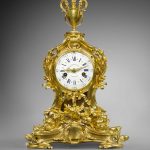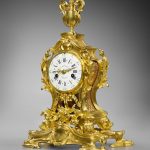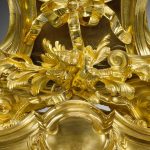A Saint-Germain model vase clock by Baillon

Pendule ancienne
A Louis XV gilt bronze clock, the dial signed Jean-Baptiste Baillon à Paris,
the case signed St Germain – circa 1755
Jean-Baptiste III Albert Baillon (d. 1772), maître on 14 July 1727
Jean-Joseph de Saint-Germain (1719-1791), maître fondeur on 15 July 1748
“by order of the King’s Council of State”
Height: 49 cm. (19 ¼ in.) Width: 37 cm. (14 ½ in.) Depth: 20.5 cm. (8 in.)
The enamel dial bearing the signature with Roman numerals indicating the hours and Arabic numerals for the minutes, gilt fleurs-de-lys between the hours and pierced and engraved gilt brass hands. The circular movement has a recoil lever escapement and silk-thread suspension and strikes the hours and half-hours by means of a count wheel mounted on the back-plate.
Provenance
Sold Christie’s Monaco, 17 June 2000, lot 274
Galerie Pascal Izarn, Paris (New Year’s greeting card, 2001)
Formerly in the Diane Collection
Comparative Literature
H. Ottomeyer and P. Pröschel, Vergoldete Bronzen, Munich, 1986, vol. I, p. 128, no. 2.8.16.
J.-D. Augarde, Les ouvriers du temps : la pendule à Paris de Louis XIV à Napoléon Ier, Paris, 1996, pp. 272-273.
J.-D. Augarde, ‘Jean-Joseph de Saint-Germain, Bronzier (1719-1791). Inédits sur sa vie et son œuvre’, L’Estampille/l’Objet d’Art., no. 308 (Dec., 1996), pp. 62-82.
The only other known version of this model surmounted with a vase is one with the dial signed Alexis Huau à Paris sold by Mes Martin et Desbenoit, Versailles, 29 May 1983, lot 131, then in the collection of Maurice Ségoura, Biennale de Monaco 1983 and eventually sold Osenat, Fontainebleau, 29 June 2008, lot 31.
Examples surmounted by Cupid include:
– One with the dial signed Huau-Saint-Amand à Paris, sold from the collection of M. de Salverte, Galerie Georges Petit, Paris, 5 and 6 May 1887, lot 75, and later in the collection of Madame Louis Burat, sold Paris, 17 June 1937, lot 75.
– One with the dial signed Le Roy, sold Christie’s London, 24 June 1971, lot 36, formerly in the collection of Anna Thomson Dodge, widow of the automobile magnate, part of whose collections are now at the Detroit Institute of Arts, USA.
– One with the dial signed Gudin à Paris, sold Sotheby’s Paris, 20 December 2005, lot 144.
– One with the dial signed Chevrau à Paris, illustrated in Ottomeyer and Pröschel, op. cit., no. 2.8.16.
Jean-Baptiste Baillon (d. 1772)
Valet de Chambre-Horloger Ordinaire de la Reine, in survivorship (1738) and in title after the death of Claude Martinot (1744). Premier Valet de Chambre de la Reine (before 1748), then Premier Valet de Chambre et Valet de Chambre-Horloger Ordinaire de la Dauphine Marie-Antoinette (1770)
The leading member of an important horological dynasty, Baillon was one of the 18th Century’s most important clockmakers, if not in terms of scientific innovation, then certainly by the extent of his business. In 1753, Berthoud described his establishment as follows:
“His maison is the finest and richest of the clock shops. Diamonds are used to decorate not only his watches, but even the clocks. He has made some whose cases were small gold boxes, decorated with diamond flowers imitating nature… His maison in Saint-Germain is a kind of manufactory. It is filled with his continually busy workers… for he alone produces a good part of Paris’s horology”
(« Sa maison est un Magasin de l’Horlogerie la plus belle et la plus riche. Le Diamant sert non seulement à décorer ses Montres, mais mêmes des pendules. Il en a fait dont les Boetes étoïent de petits Cartels d’Or, ornés de fleurs de Diamants imitant la nature… Sa maison de St-Germain est une espèce de Manufacture. Elle est remplie d’Ouvriers continuellement occupés pour lui… puisque lui seul fait une bonne partie de l’Horlogerie de Paris »)
(quoted in Augarde 1996a, op. cit., pp. 272-273)
Jean-Joseph de Saint-Germain (1719-1791)
Son of a master cabinetmaker and talented bronze worker, Jean-Joseph de Saint-Germain was an undisputed master of the Rococo style who created famous models of clocks that featured animals in their decoration. A modeler and chaser, and a botanist by passion, he also knew how to adapt to the neo-classical aesthetic. His output from 1760 onwards is entirely of clocks; they all reveal an adoption of Greek taste in its theoretical purity, giving rise to objects of an elegance and refinement that are often extreme, such as the clock with the Four Winds or that with the Allegory of the Battle of Fontenoy (see Augarde 1996b, op. cit., pp. 62-82).



